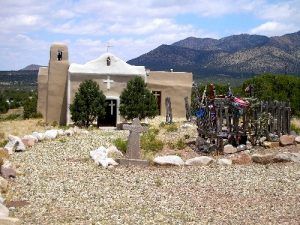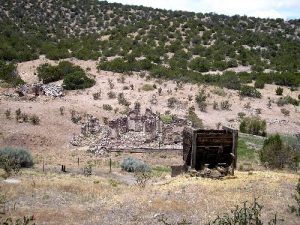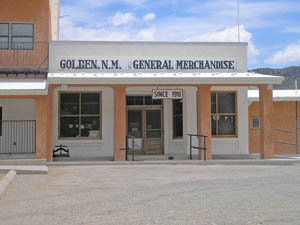Golden, New Mexico, was inhabited by Native Americans and Spaniards long before American settlers came to the area. However, it began to boom when gold was discovered in 1825.
Years before the California and Colorado gold rushes, the site of Golden became the first gold rush west of the Mississippi River. Placer gold was first discovered on Tuerto Creek on the southwest side of the Ortiz Mountains, and in the late 1820s, two small mining camps developed as a result of the mineral finds — El Real de San Francisco and Placer del Tuerto.
For decades, the area remained quiet until several large companies began to put money into the mines, bringing in numerous workers, and followed by many individual prospectors. Shortly after these mining camps were formed that the San Francisco Catholic Church was built around 1830.
Just south of Tuerto, a new town called Golden was being formed, which soon absorbed El Real de San Francisco and Placer del Tuerto. Officially formed in 1879, Golden was selected as the center of the new gold-mining district and soon grew to support several saloons, businesses, a school, and even a stock exchange. In 1880, the post office was opened.
However, the expectations of Golden’s miners were soon deflated, as by 1884, the gold was already beginning to dwindle, and people began to leave the area. But, mining continued on a small scale until about 1892, and ranching continued to be a mainstay of the economy. In 1918 the Golden General Merchandise Store was opened by Ernest Ricon. In the 1960s, a man named Henderson married Ricon’s daughter, and they took over the store. It is the only business in town that continues to operate today (or at least upon our last visit in 2006) and is referred to by the locals as the Henderson General Store.
By 1928, the population was so reduced that the post office closed, and Golden officially became a ghost town. For years afterward, its many abandoned buildings remained, tumbling down between its few remaining occupied structures. During this time, vandalism took its toll on the town and its remaining structures, but a few crumbling ruins still provide excellent photo opportunities. Golden’s most photographed building is the San Francisco Catholic Church, which was restored by historian and author Fray Angelico Chavez in 1960 while he was the St. Joseph Church’s padre in Los Cerrillos. Across the highway, west of the church, are the ruins of another large structure and mining remnants.
Golden has seen a small rebirth as new residents have moved into the area, building new homes and restoring others, but still, it remains a sleepy village with vivid reminders of its more robust past.
Nearby Golden are the traceable ruins of a pueblo called Paa-Ko that dates back to about 1300 A.D. Abandoned around 1670; there is little to be seen today. The site was commissioned as a New Mexico State Monument in 1938 but was decommissioned in 1959. Located just north of the Crest turnoff, little remains can be seen at the site that is now utilized for archeology digs by universities and researchers.
Golden is located along the Turquoise Trail Scenic Byway; Golden is about ten miles north of the Sandia Park Junction on NM 14.
© Kathy Weiser-Alexander/Legends of America, updated April 2021.
Also See:
The Turquoise Trail Scenic Byway
Madrid, New Mexico – A Ghost Town Reborn
Los Cerrillos, New Mexico – Two Thousand Years of History



